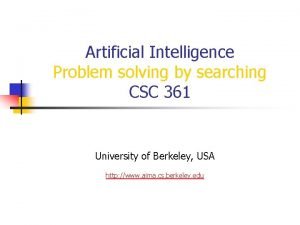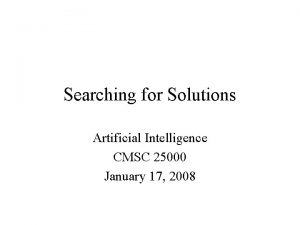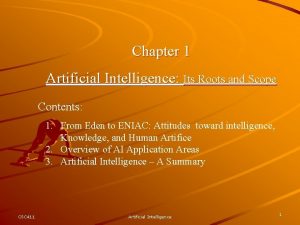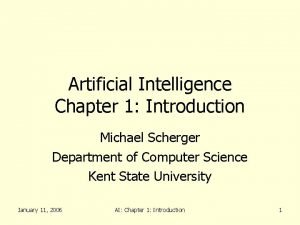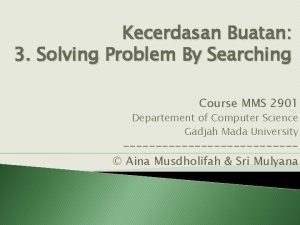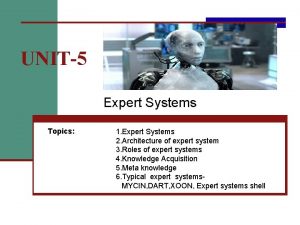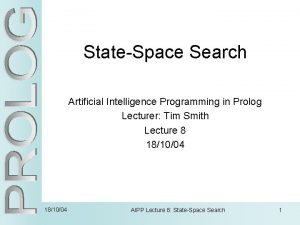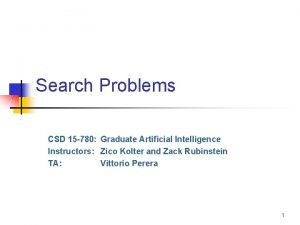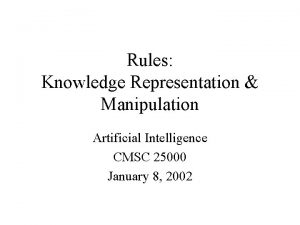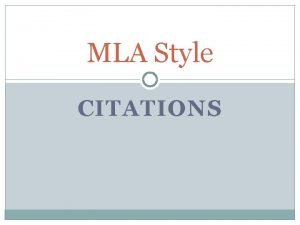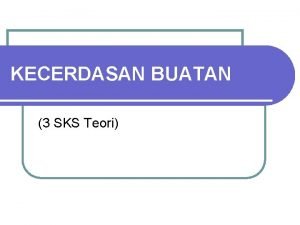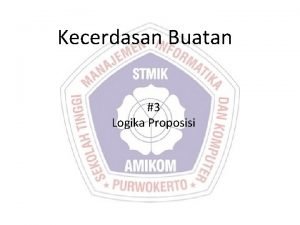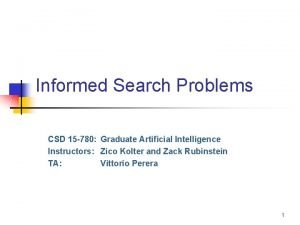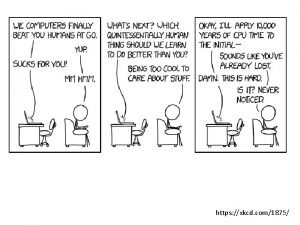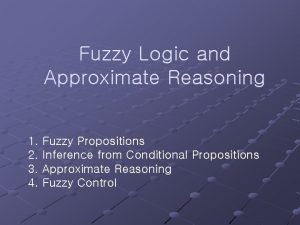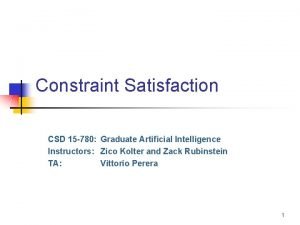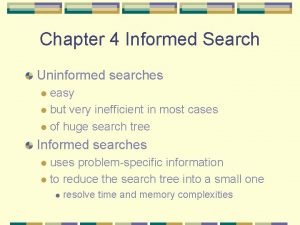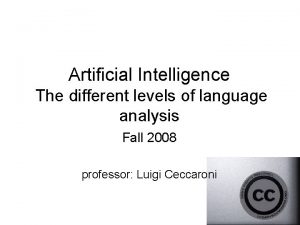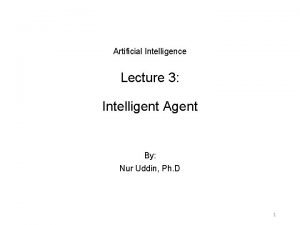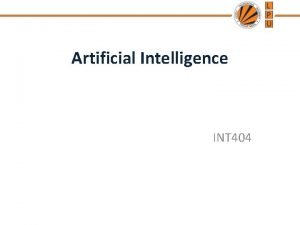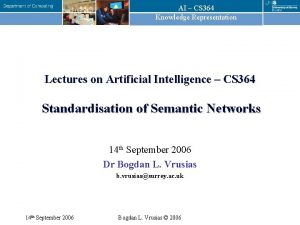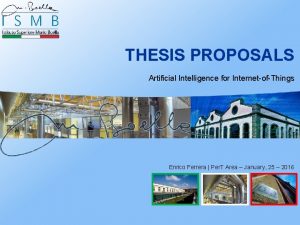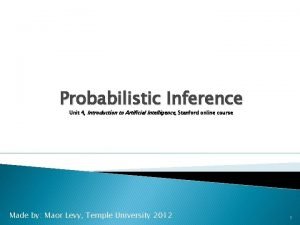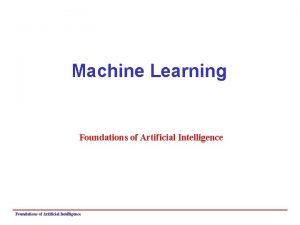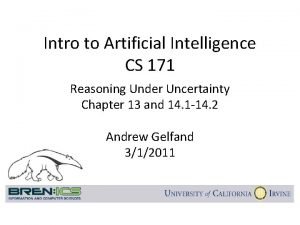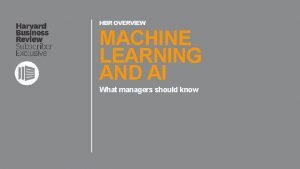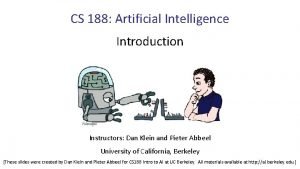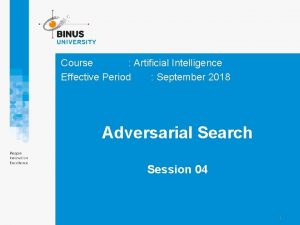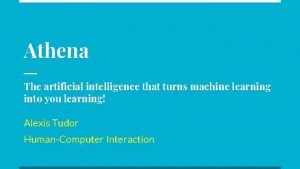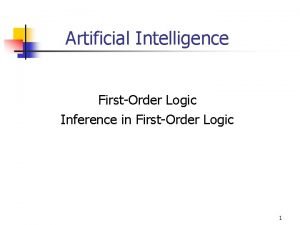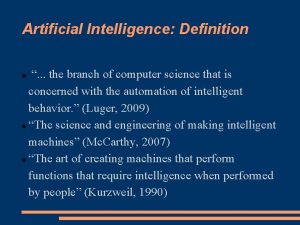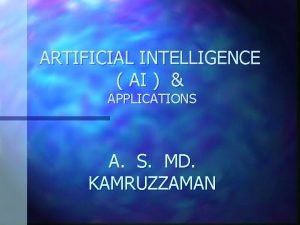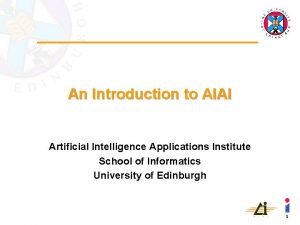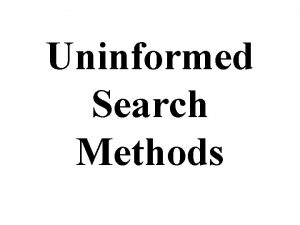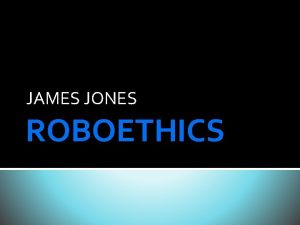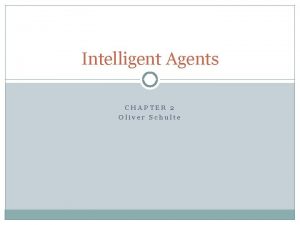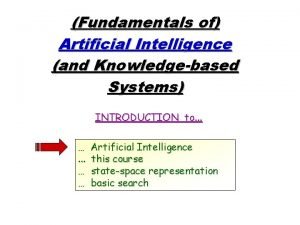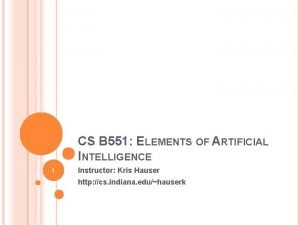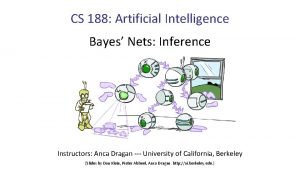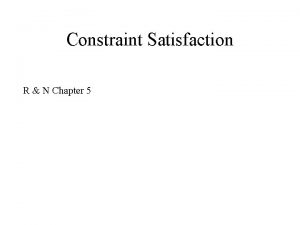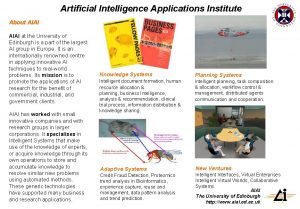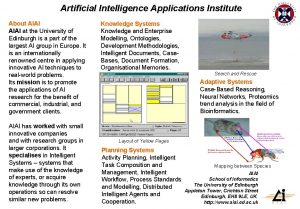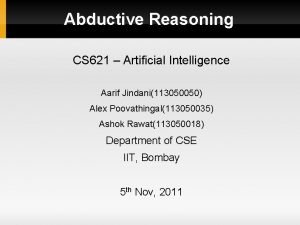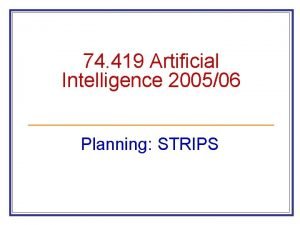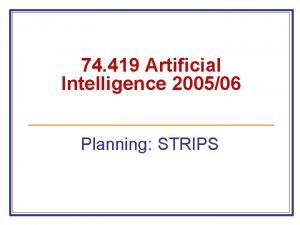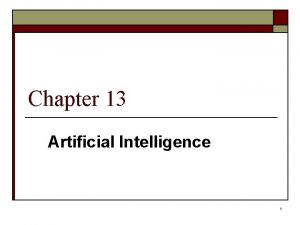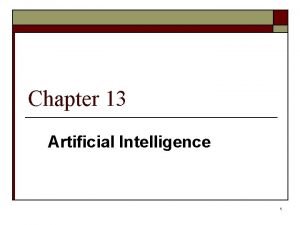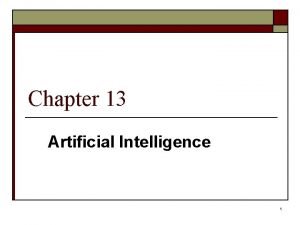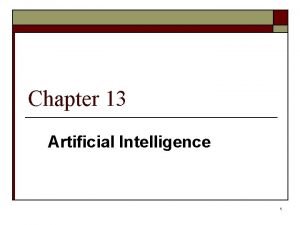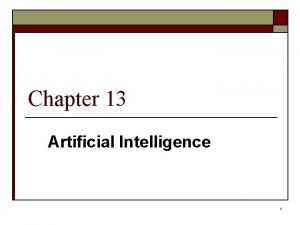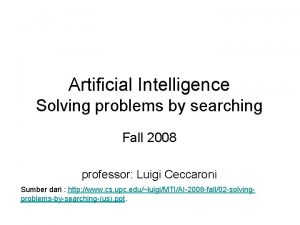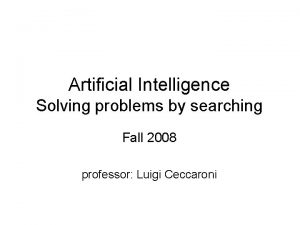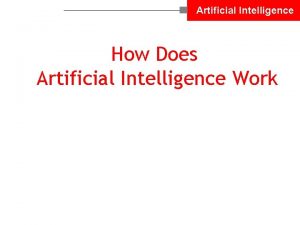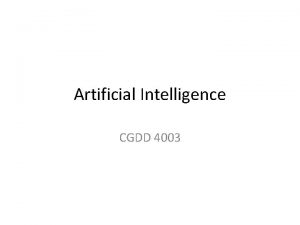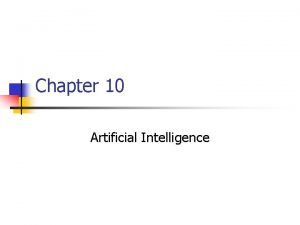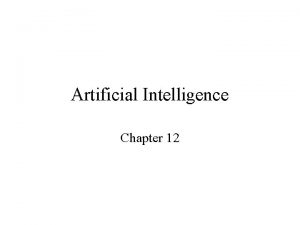Artificial Intelligence Chapter 3 Solving Problems by Searching

Artificial Intelligence Chapter 3: Solving Problems by Searching Michael Scherger Department of Computer Science Kent State University January 26, 2003 AI: Chapter 3: Solving Problems by Searching 1

Problem Solving Agents • Problem solving agent – A kind of “goal based” agent – Finds sequences of actions that lead to desirable states. • The algorithms are uninformed – No extra information about the problem other than the definition • No extra information • No heuristics (rules) January 26, 2003 AI: Chapter 3: Solving Problems by Searching 2

Goal Based Agent State What the world is like now Sensors Percepts Environment How the world evolves What my actions do Goals January 26, 2003 What it will be like if I do action A What action I should do now Actuators AI: Chapter 3: Solving Problems by Searching Actions 3

Goal Based Agent Function Simple-Problem-Solving-Agent( percept ) returns action Inputs: percept Static: seq state goal problem a percept an action sequence initially empty some description of the current world a goal, initially null a problem formulation state <- UPDATE-STATE( state, percept ) if seq is empty then do goal <- FORMULATE-GOAL( state ) problem <- FORMULATE-PROBLEM( state, goal ) seq <- SEARCH( problem ) action <- RECOMMENDATION ( seq ) seq <- REMAINDER( seq ) return action January 26, 2003 AI: Chapter 3: Solving Problems by Searching # SEARCH # SOLUTION # EXECUTION 4

Goal Based Agents • Assumes the problem environment is: – Static • The plan remains the same – Observable • Agent knows the initial state – Discrete • Agent can enumerate the choices – Deterministic • Agent can plan a sequence of actions such that each will lead to an intermediate state • The agent carries out its plans with its eyes closed – Certain of what’s going on – Open loop system January 26, 2003 AI: Chapter 3: Solving Problems by Searching 5

Well Defined Problems and Solutions • A problem – Initial state – Actions and Successor Function – Goal test – Path cost January 26, 2003 AI: Chapter 3: Solving Problems by Searching 6

Example: Water Pouring • Given a 4 gallon bucket and a 3 gallon bucket, how can we measure exactly 2 gallons into one bucket? – There are no markings on the bucket – You must fill each bucket completely January 26, 2003 AI: Chapter 3: Solving Problems by Searching 7

Example: Water Pouring • Initial state: – The buckets are empty – Represented by the tuple ( 0 0 ) • Goal state: – One of the buckets has two gallons of water in it – Represented by either ( x 2 ) or ( 2 x ) • Path cost: – 1 per unit step January 26, 2003 AI: Chapter 3: Solving Problems by Searching 8

Example: Water Pouring • Actions and Successor Function – Fill a bucket • (x y) -> (3 y) • (x y) -> (x 4) – Empty a bucket • (x y) -> (0 y) • (x y) -> (x 0) – Pour contents of one bucket into another • (x y) -> (0 x+y) or (x+y-4, 4) • (x y) -> (x+y 0) or (3, x+y-3) January 26, 2003 AI: Chapter 3: Solving Problems by Searching 9

Example: Water Pouring January 26, 2003 AI: Chapter 3: Solving Problems by Searching 10

Example: Eight Puzzle • States: – Description of the eight tiles and location of the blank tile • Successor Function: – Generates the legal states from trying the four actions {Left, Right, Up, Down} 7 5 8 2 1 4 7 2 5 8 3 4 6 1 • Goal Test: – Checks whether the state matches the goal configuration • Path Cost: – Each step costs 1 January 26, 2003 AI: Chapter 3: Solving Problems by Searching 3 6 11

Example: Eight Puzzle • Eight puzzle is from a family of “sliding – block puzzles” – NP Complete – 8 puzzle has 9!/2 = 181440 states – 15 puzzle has approx. 1. 3*1012 states – 24 puzzle has approx. 1*1025 states January 26, 2003 AI: Chapter 3: Solving Problems by Searching 12

Example: Eight Queens • Place eight queens on a chess board such that no queen can attack another queen Q Q • No path cost because only the final state counts! • Incremental formulations • Complete state formulations January 26, 2003 Q Q Q AI: Chapter 3: Solving Problems by Searching Q 13

Example: Eight Queens • States: Q – Any arrangement of 0 to 8 queens on the board • Initial state: – No queens on the board • Successor function: Q Q Q – Add a queen to an empty square Q • Goal Test: – 8 queens on the board and none are attacked • 64*63*…*57 = 1. 8*1014 possible sequences Q Q – Ouch! January 26, 2003 AI: Chapter 3: Solving Problems by Searching Q 14

Example: Eight Queens • States: – Arrangements of n queens, one per column in the leftmost n columns, with no queen attacking another are states Q Q • Successor function: – Add a queen to any square in the leftmost empty column such that it is not attacked by any other queen. • 2057 sequences to investigate January 26, 2003 Q Q Q AI: Chapter 3: Solving Problems by Searching Q 15

Other Toy Examples • • • Another Another January 26, 2003 Example: Example: Jug Fill Black White Marbles Row Boat Problem Sliding Blocks Triangle Tee AI: Chapter 3: Solving Problems by Searching 16

Example: Map Planning January 26, 2003 AI: Chapter 3: Solving Problems by Searching 17

Searching For Solutions • Initial State – e. g. “At Arad” • Successor Function – A set of action state pairs – S(Arad) = {(Arad->Zerind, Zerind), …} • Goal Test – e. g. x = “at Bucharest” • Path Cost – sum of the distances traveled January 26, 2003 AI: Chapter 3: Solving Problems by Searching 18

Searching For Solutions • Having formulated some problems…how do we solve them? • Search through a state space • Use a search tree that is generated with an initial state and successor functions that define the state space January 26, 2003 AI: Chapter 3: Solving Problems by Searching 19

Searching For Solutions • A state is (a representation of) a physical configuration • A node is a data structure constituting part of a search tree – Includes parent, children, depth, path cost • States do not have children, depth, or path cost • The EXPAND function creates new nodes, filling in the various fields and using the SUCCESSOR function of the problem to create the corresponding states January 26, 2003 AI: Chapter 3: Solving Problems by Searching 20

Searching For Solutions January 26, 2003 AI: Chapter 3: Solving Problems by Searching 21

Searching For Solutions January 26, 2003 AI: Chapter 3: Solving Problems by Searching 22

Searching For Solutions January 26, 2003 AI: Chapter 3: Solving Problems by Searching 23

Uninformed Search Strategies • Uninformed strategies use only the information available in the problem definition – Also known as blind searching • • • Breadth-first search Uniform-cost search Depth-first search Depth-limited search Iterative deepening search January 26, 2003 AI: Chapter 3: Solving Problems by Searching 24

Comparing Uninformed Search Strategies • Completeness – Will a solution always be found if one exists? • Time – How long does it take to find the solution? – Often represented as the number of nodes searched • Space – How much memory is needed to perform the search? – Often represented as the maximum number of nodes stored at once • Optimal – Will the optimal (least cost) solution be found? • Page 81 in AIMA text January 26, 2003 AI: Chapter 3: Solving Problems by Searching 25

Comparing Uninformed Search Strategies • Time and space complexity are measured in – b – maximum branching factor of the search tree – maximum depth of the state space – depth of the least cost solution January 26, 2003 AI: Chapter 3: Solving Problems by Searching 26

Breadth-First Search • Recall from Data Structures the basic algorithm for a breadth-first search on a graph or tree • Expand the shallowest unexpanded node • Place all new successors at the end of a FIFO queue January 26, 2003 AI: Chapter 3: Solving Problems by Searching 27

Breadth-First Search January 26, 2003 AI: Chapter 3: Solving Problems by Searching 28

Breadth-First Search January 26, 2003 AI: Chapter 3: Solving Problems by Searching 29

Breadth-First Search January 26, 2003 AI: Chapter 3: Solving Problems by Searching 30

Breadth-First Search January 26, 2003 AI: Chapter 3: Solving Problems by Searching 31

Properties of Breadth-First Search • Complete – Yes if b (max branching factor) is finite • Time – 1 + b 2 + … + bd + b(bd-1) = O(bd+1) – exponential in d • Space – O(bd+1) – Keeps every node in memory – This is the big problem; an agent that generates nodes at 10 MB/sec will produce 860 MB in 24 hours • Optimal – Yes (if cost is 1 per step); not optimal in general January 26, 2003 AI: Chapter 3: Solving Problems by Searching 32

Lessons From Breadth First Search • The memory requirements are a bigger problem for breadth-first search than is execution time • Exponential-complexity search problems cannot be solved by uniformed methods for any but the smallest instances January 26, 2003 AI: Chapter 3: Solving Problems by Searching 33

Uniform-Cost Search • Same idea as the algorithm for breadthfirst search…but… – Expand the least-cost unexpanded node – FIFO queue is ordered by cost – Equivalent to regular breadth-first search if all step costs are equal January 26, 2003 AI: Chapter 3: Solving Problems by Searching 34

Uniform-Cost Search • Complete – Yes if the cost is greater than some threshold – step cost >= ε • Time – Complexity cannot be determined easily by d or d – Let C* be the cost of the optimal solution – O(bceil(C*/ ε)) • Space – O(bceil(C*/ ε)) • Optimal – Yes, Nodes are expanded in increasing order January 26, 2003 AI: Chapter 3: Solving Problems by Searching 35

Depth-First Search • Recall from Data Structures the basic algorithm for a depth-first search on a graph or tree • Expand the deepest unexpanded node • Unexplored successors are placed on a stack until fully explored January 26, 2003 AI: Chapter 3: Solving Problems by Searching 36

Depth-First Search January 26, 2003 AI: Chapter 3: Solving Problems by Searching 37

Depth-First Search January 26, 2003 AI: Chapter 3: Solving Problems by Searching 38

Depth-First Search January 26, 2003 AI: Chapter 3: Solving Problems by Searching 39

Depth-First Search January 26, 2003 AI: Chapter 3: Solving Problems by Searching 40

Depth-First Search January 26, 2003 AI: Chapter 3: Solving Problems by Searching 41

Depth-First Search January 26, 2003 AI: Chapter 3: Solving Problems by Searching 42

Depth-First Search January 26, 2003 AI: Chapter 3: Solving Problems by Searching 43

Depth-First Search January 26, 2003 AI: Chapter 3: Solving Problems by Searching 44

Depth-First Search January 26, 2003 AI: Chapter 3: Solving Problems by Searching 45

Depth-First Search January 26, 2003 AI: Chapter 3: Solving Problems by Searching 46

Depth-First Search January 26, 2003 AI: Chapter 3: Solving Problems by Searching 47

Depth-First Search January 26, 2003 AI: Chapter 3: Solving Problems by Searching 48

Depth-First Search • Complete – No: fails in infinite-depth spaces, spaces with loops • Modify to avoid repeated spaces along path – Yes: in finite spaces • Time – O(bm) – Not great if m is much larger than d – But if the solutions are dense, this may be faster than breadthfirst search • Space – O(bm)…linear space • Optimal – No January 26, 2003 AI: Chapter 3: Solving Problems by Searching 49

Depth-Limited Search • A variation of depth-first search that uses a depth limit – Alleviates the problem of unbounded trees – Search to a predetermined depth l (“ell”) – Nodes at depth l have no successors • Same as depth-first search if l = ∞ • Can terminate for failure and cutoff January 26, 2003 AI: Chapter 3: Solving Problems by Searching 50

Depth-Limited Search January 26, 2003 AI: Chapter 3: Solving Problems by Searching 51

Depth-Limited Search • Complete – Yes if l < d • Time – O(bl) • Space – O(bl) • Optimal – No if l > d January 26, 2003 AI: Chapter 3: Solving Problems by Searching 52

Iterative Deepening Search • Iterative deepening depth-first search – Uses depth-first search – Finds the best depth limit • Gradually increases the depth limit; 0, 1, 2, … until a goal is found January 26, 2003 AI: Chapter 3: Solving Problems by Searching 53

Iterative Deepening Search January 26, 2003 AI: Chapter 3: Solving Problems by Searching 54

Iterative Deepening Search January 26, 2003 AI: Chapter 3: Solving Problems by Searching 55

Iterative Deepening Search January 26, 2003 AI: Chapter 3: Solving Problems by Searching 56

Iterative Deepening Search January 26, 2003 AI: Chapter 3: Solving Problems by Searching 57

Iterative Deepening Search January 26, 2003 AI: Chapter 3: Solving Problems by Searching 58

Iterative Deepening Search • Complete – Yes • Time – O(bd) • Space – O(bd) • Optimal – Yes if step cost = 1 – Can be modified to explore uniform cost tree January 26, 2003 AI: Chapter 3: Solving Problems by Searching 59

Lessons From Iterative Deepening Search • Faster than BFS even though IDS generates repeated states – BFS generates nodes up to level d+1 – IDS only generates nodes up to level d • In general, iterative deepening search is the preferred uninformed search method when there is a large search space and the depth of the solution is not known January 26, 2003 AI: Chapter 3: Solving Problems by Searching 60
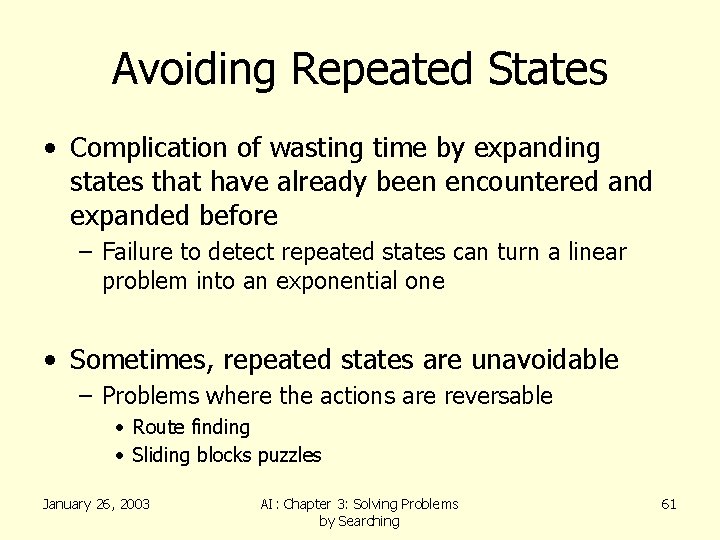
Avoiding Repeated States • Complication of wasting time by expanding states that have already been encountered and expanded before – Failure to detect repeated states can turn a linear problem into an exponential one • Sometimes, repeated states are unavoidable – Problems where the actions are reversable • Route finding • Sliding blocks puzzles January 26, 2003 AI: Chapter 3: Solving Problems by Searching 61

Avoiding Repeated States State Space January 26, 2003 Search Tree AI: Chapter 3: Solving Problems by Searching 62

Avoiding Repeated States January 26, 2003 AI: Chapter 3: Solving Problems by Searching 63
- Slides: 63


